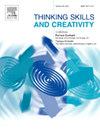Long in the tooth for creativity? Differences in divergent thinking between young and older adults
IF 3.7
2区 教育学
Q1 Social Sciences
引用次数: 0
Abstract
Young and older adults require creative skills in their daily lives to solve problems professionally and personally. The capacity for creative thinking is influenced by various changes that occur throughout the life cycle. The objectives of this study include testing the measurement invariance of the PIC-A test and exploring whether significant differences in creative thinking exist between young and older adults. 210 young adults and 131 older adults participated in the study (341 subjects in total). First, a confirmatory factor analysis (CFA) was conducted with the full sample, followed by CFAs for each age subgroup. Subsequently, a multi-group of measurement invariance routine was tested with configural, metric and scalar invariance. The 2-factor CFA model for the full sample showed adequate fit (χ2=42.537; df =13; p<.001, CFI =0.967; RMSEA = 0.082 [.055–0.109]; SRMR = 0.050) although the Graphic Originality test did not exhibit a significant loading on the Graphic Creativity Factor and was not removed from the model for consistency with the original scale. The model fit indices for the young adult and older adult groups were acceptable. Results showed age-related differences in both narrative and graphic creativity, with higher scores in the young adult group. Finally, the study provides hypothetical explanations for differences in divergent thinking performance in light of theories such as inhibition, assimilationaccommodation, and socioemotional theory. For example, the role of potential distractors, the old adults reduced tendency to take risks, or their preference for practical and emotionally satisfying responses when solving problems.
创造力的年龄太大了?年轻人和老年人发散性思维的差异
年轻人和老年人在日常生活中需要创造性的技能来解决专业和个人的问题。创造性思维的能力受到生命周期中发生的各种变化的影响。本研究的目的包括检验PIC-A测验的测量不变性,并探讨创造性思维在年轻人和老年人之间是否存在显著差异。210名年轻人和131名老年人参与了这项研究(总共341名受试者)。首先,对整个样本进行验证性因子分析(CFA),然后对每个年龄亚组进行验证性因子分析。随后,对多组测量不变性例程进行了构形、度量和标量不变性测试。全样本的2因素CFA模型拟合良好(χ2=42.537;df = 13;术;。001, cfi =0.967;Rmsea = 0.082 [.055-0.109];SRMR = 0.050),尽管图形创意测试没有显示出图形创意因子的显著负荷,并且没有从模型中删除,以保持与原始量表的一致性。青壮年组和老年人组的模型拟合指标均可接受。结果显示,在叙事和图形创造力方面存在年龄相关的差异,年轻人的得分更高。最后,本研究从抑制理论、同化适应理论和社会情绪理论等方面对发散性思维表现差异进行了假设解释。例如,潜在的干扰因素的作用,老年人降低了冒险的倾向,或者他们在解决问题时更倾向于实际和情感上满意的反应。
本文章由计算机程序翻译,如有差异,请以英文原文为准。
求助全文
约1分钟内获得全文
求助全文
来源期刊

Thinking Skills and Creativity
EDUCATION & EDUCATIONAL RESEARCH-
CiteScore
6.40
自引率
16.20%
发文量
172
审稿时长
76 days
期刊介绍:
Thinking Skills and Creativity is a new journal providing a peer-reviewed forum for communication and debate for the community of researchers interested in teaching for thinking and creativity. Papers may represent a variety of theoretical perspectives and methodological approaches and may relate to any age level in a diversity of settings: formal and informal, education and work-based.
 求助内容:
求助内容: 应助结果提醒方式:
应助结果提醒方式:


